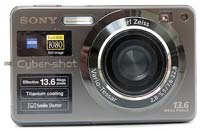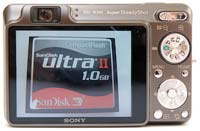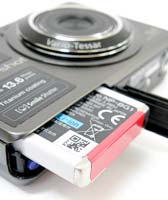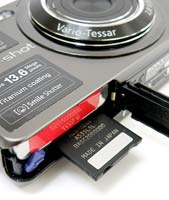Sony Cyber-shot DSC-W300 Review
Review Date: August 20th 2008
Author: Gavin Stoker
Leave a comment about this Review
|
Introduction

The Sony Cyber-shot DSC-W300 is the top of the range model in Sony's W-series of premium compact digital cameras. The W300 is a new 13.6 megapixel model with a scratch-resistant titanium coating, 3x optical zoom lens equivalent to 35-105mm, and a large 2.7 inch LCD screen. There's also a traditional and increasingly rare optical viewfinder, Smile Shutter and Face Detection technologies, Super Steady Shot image stabilizer to reduce camera shake, HD Output to you high-dev TV set, and Intelligent Scene Recognition which automatically selects the correct shooting mode depending on the subject. Currently available for around �250 / $350, Gavin Stoker finds out if the Sony DSC-W300 is as effective as it it good-looking...
Compare Prices
Support PhotographyBLOG: Buy the Sony Cyber-shot DSC-W300 from one of our affiliate retailers:Ease of Use
Offering the photo enthusiast point and shoot simplicity along with a dash of style is the sleekly fashioned Cyber-shot DSC-W300 from Sony. But it's not all about carefully crafted titanium surface detail or even Carl Zeiss Vario-Tessar 3x optical zoom lens, though Sony makes a great play of both. No, the W300's internal sensor also boasts 13.6 million effective pixels, bettering the resolution of most consumer level DSLRs. And of course the W300 can be hooked up to one of Sony's latest generation High Definition TV sets via optional cabling, while a combination USB 2.0 plus standard definition AV cable is included in the box. Funny, but hardly surprising, how manufacturers are increasingly making a major selling point out of digicams 'full HD' properties � not exactly the big deal it might first seem as a High Def 1920x1080 TV signal equates to just two megapixels in terms of image quality. The W300 even has a playback mode that lets you convert standard 4:3 ratio digital images to 16:9 ratio for your TV set, while resolution handily drops to two megapixels � not a pixel more, not a pixel less, into the bargain. But, as someone once sagely said, there's more to life than telly.
A tad larger than a credit card with dimensions of 94.3x59x26.8mm, the head-turning Sony Cyber-shot DSC-W300 feels solid and weighty enough at 187g (including battery) when gripped in the palm. In fact it feels like it might withstand war or earthquake, never mind the cocktail bars of Milan. Given that, its UK asking price of �248.99 � while certainly not cheap given the current market � doesn't seem unreasonable either. By the look of the box our review sample arrived in, the camera had been around the block a good few times. Even so, the scratch resistant faceplate was refreshingly free from scuffs (if not fingerprints) and though there were a couple of minor scratches on the 2.7-inch, 230k dot LCD this didn't detract from overall visibility, indoors or out. Unusually, given the compact dimensions of the camera and the relative huge-ness of the screen, you do get an optical viewfinder as an alternative for composition and framing, even if it is so eye squintingly small you'll probably not bother with it.
Other key features to mention include such Sony regulars as a Bionz processor that powers the likes of its Smile Shutter function � whereby the camera automatically takes the shot when your subject grins � plus Face Detection. The manufacturer claims to have further improved the latter on the W300 to track (up to 8) subjects faster and also distinguish between children and adults. Further boosting the family-friendly levels of hand holding on offer are a D-Range Optimiser to deliver natural looking exposures even with brightly backlit scenes, intelligent scene recognition (detecting up to five different scenarios), frill-free 'easy 'shooting mode and a smattering of in-camera image editing capabilities, along with a new underwater scene mode.
 |
 |
| Front | Rear |
Super Steady Shot image stabilisation that can be set to continuous or activated only when the shutter release is pressed, also makes a return. Offering the possibility for low light photography with flash are manually selectable ISO options up to ISO 3200, with a dedicated ISO+ setting boosting this up to ISO 6400, but with the compromise of available resolution dropping to three megapixels. A note of caution though: the W300 will quite happily take the shot even though critical focus hasn't been achieved and/or you're too close to the subject. At times too, when reviewing maximum resolution images on the rear LCD, the image will take a second of so to 'build' from a blurred to sharp reproduction. Though this isn't that uncommon, a five frames per second continuous shooting offering in the W300's High Speed Burst mode is, while JPEG images and MPEG1 mono audio 640x480 pixel video clips are either committed to 15MB internal memory or optional Memory Stick Duo card.
With the above in mind let's take a brief guided tour of the Sony Cyber-shot DSC-W300's features and functions to discover how well it's been thought through � and how convincingly it responds. With its silver-grey hue, the attractive titanium front of the W300 is desirably minimal but stylishly furnished in an Art Deco sort of way, a centerpiece being made of its Carl Zeiss optics; the raised lens surround complete with large font inscription bearing its supplier's name. While the lens barrel itself is hidden within the body when the camera is turned off, activate the power and the automatic lens cover flips open, the barrel rapidly extending to maximum wide-angle setting.
Examining the Sony Cyber-shot DSC-W300's faceplate closer, top right is a teeny square window for the aforementioned optical viewfinder, adjacent to which is a porthole for the self-timer/smile shutter lamp. Jumping over to the left hand side of the lens we find a row of three pinpricks giving away the location of the built in microphone and lozenge shaped bulb for the built-in flash. Moving to the slender top-plate of the W300, the flash design is mirrored in the recessed shutter release button being almost an identical size and shape. This has a definite halfway point when depressed, at which juncture green AF points (with a choice of either multi, centre or spot) illuminate on screen and a loud beep sounds by way of focus/exposure confirmation. Next to the shutter release is a completely recessed on/off button with 'power' stenciled alongside it, followed by a trough containing four holes for the built-in speaker. Press the power button and the camera bursts into life with an ident-like audio flourish, a wait of about a second and a half before you can fire off a shot. In powering down however the camera seems slower to respond, pausing for a second or so before the lens begins to retract and the screen goes blank. The W300 is however reasonably swift to determine focus and exposure � if not lightning fast � while a full resolution image takes 2-3 seconds to be fully committed to memory when shooting at single shot capture speed.
 |
 |
| Top | Bottom |
While the left hand of the Sony Cyber-shot DSC-W300 � if viewed from the rear � is devoid of any features entirely, save for a inscription highlighting the internally stacked 3x optical zoom, the right hand flank features a loop for attaching a wrist strap. The latter is a very good idea as, as with most slim-line compacts, there's not much for your fingers or thumbs to actually get a purchase on, and, leaning over the edge of a bridge for some of our test shots I was fearful of the camera slipping from my grasp if buffeted by a strong gust of wind.
Moving to the back of the W300 we find a good three quarters of real estate taken up by the composition/review screen. Next to the optical viewfinder above, and ranged to left hand side of the body, are a pair of lamps that flash green when determining focus and exposure, and orange when committing an image to memory. Over on the top right hand side of the camera back is another slender lozenge shaped control, this time a rocker switch for the zoom. Press on the right hand side to power through the range to maximum telephoto and you'll be rewarded with a fairly smooth action, albeit sound-tracked by a low mechanical buzz that will only in truth be noticed in a quiet room with no distractions.
Immediately beneath this we find a halfpenny (or dime) sized mode wheel.� Unusually for a point and shoot snapper there is no only an 'auto everything' mode, but also program and manual variations (the latter allowing adjustment of aperture plus shutter speed), and each twist is mirrored by a virtual wheel on screen with a brief but useful explanation of the chosen setting.�Moving anti clockwise around the dial we come to the aforementioned video mode, and next alight upon the scene mode. With a press of the 'menu' button lurking just below, here you get access to a pull-out onscreen toolbar offering the likes of 'soft snap' which throws the background out of focus for effective portraiture, the more familiar landscape and twilight portrait, plus beach, snow, fireworks and the previously mentioned underwater mode, for which you'll need to invest In protective camera housing.
The next mode around the dial is that for the fully auto smile shutter function, while that three megapixel continuous shooting mode follows. Next up is the extra high sensitivity (up to ISO6400 equivalent) mode that again drops pixel count to three million to compensate for possible image noise, while the consecutive setting on the dial is for auto ISO when shooting in low light. Then we come to the last mode, 'Easy' mode, which as it sounds pares down shooting options to just image size � here a simplistic 'large' or 'small' � and turns the flash either on or off. And that's it. So far so user friendly.
 |
 |
| Battery Compartment | Memory Card Slot |
Below the mode wheel is the menu button we briefly touched on. Depending on the chosen mode, and with the exception of easy mode, here you get access to a toolbar ranged down the left hand side of the screen. In for example program mode, this provides access to adjusting image size (In terms of pixel count), turning face detection on, off, or utilising it to bias either children or adults in the frame, along with record mode (single shot, continuous) or one of three bracketing modes (three shots at +/- 0.3EV, +/- 0.7EV or +/- 1.0EV apart). That's not to mention various in-camera image effects (such as normal, vivid or, curiously, 'real' colours, i.e less saturated, plus red, green or blue colour filters). And of course there's the expected ability to manually tweak light sensitivity between ISO 80 and ISO 3200, alongside white balance.
While all that is pretty standard stuff, the Dynamic Range Optimiser option is a definite aid for the uninitiated and with which the user can either adjust the brightness and contrast of the entire scene or area by area. Another boon is Super SteadyShot anti-shake of course. To the right of the menu button is another slightly smaller button marked 'home' that is described by the W300'S manual as a 'gateway' to all camera functions. As we noted in our recent review of Sony's H50 super zoom, this setting can be called up regardless of whatever mode you're in, and is best viewed something of a 'housekeeping' control, as pressing it affords access to more general options including the ability to adjust sounds or format the memory card. Below these two buttons is a familiar four way control pad with central unmarked button that does the same job as an 'OK' button on most other digital compacts � i.e implements whichever setting or effect you have chosen from the menu options by tabbing up or down, left or right courtesy of the four way control pad itself.
Ranged at the four points around the pad are a means of calling up or deactivating the onscreen display information, selecting from the various flash options, self-timer and either macro or super macro modes. Beneath this again, and the same size as the menu button, is a third marked with the familiar playback symbol, while next to it is a dedicated button for calling up a slideshow of images with pleasant music � indicating the Sony Cyber-shot DSC-W300 is as much about sharing images as capturing them.
Moving to the base of the W300 finally we find a screw thread for a tripod ranged far to one side, while at the other end is a sliding door protecting the compartment for both the rechargeable battery provided and the Memory Stick Duo card slot. A lithium-ion cell good for up to 300 shots when charged is again pretty standard stuff. Between screw thread and hidden compartment is an unprotected slot for attaching the provided dual use cabling � and incidentally a camera dock is available as an optional extra.
So what of the Sony Cyber-shot DSC-W300's image quality then? Though it might offer point and shot simplicity on the one hand, and a plethora of in-camera tweaks on the other to stop enthusiasts from dying of boredom, at the end of the day are results as eye-catching as its outer shell?
|
![]() PhotographyBLOG
is a member of the DIWA
organisation. Our test results for the Sony Cyber-shot DSC-W300 have been submitted to DIWA
for comparison with test results for different samples of
the same camera model supplied by other DIWA
member sites.
PhotographyBLOG
is a member of the DIWA
organisation. Our test results for the Sony Cyber-shot DSC-W300 have been submitted to DIWA
for comparison with test results for different samples of
the same camera model supplied by other DIWA
member sites.
